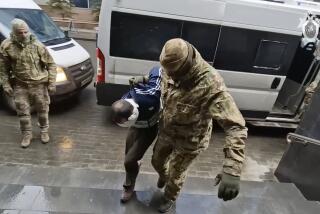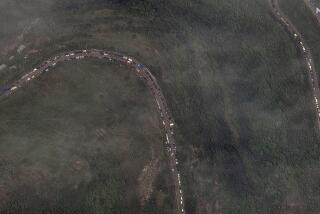Special Report: Seeking a New World : Case Study / ‘Turkestan’ : A Mythical Empire May Be on the Verge of a Bloody Civil War : Ethnic clashes mar the dream of a Muslim federation in Central Asia.
- Share via
TASHKENT, Soviet Union — In the remotest corner of the world, on the plains where Tamerlane and Genghis Khan once ruled, an empire is on the verge of civil war--with the potential to transform the map from the Middle East to the gates of China.
Pitting Kirghiz against Uzbek and Uzbek against Meshketian, the new ethnic battles of Central Asia are being fought among places most Americans have never heard of. Yet more than 1,000 people have died in the clashes, according to Soviet estimates, and more death and destruction appear inevitable.
“The world should prepare itself for . . . the bloodiest ethnic, cultural and civil conflicts,” warned Valeri Tishkov, one of the leading Soviet experts on such strife.
But even as each group in this ethnic crazy quilt arms itself for war, an unprecedented effort is also under way to unite all the peoples of the region in a Muslim federation that could stretch from European Turkey to the far side of the Himalayas--the age-old dream of “Turkestan.”
The Communist governments of the five republics of Soviet Central Asia have met together to plot a common destiny; so have the dissident movements that want to throw the Communists out. The region’s Muslim fundamentalists have joined in an Islamic Democratic Party to promote religious rebellion against Soviet rule. And to the east, in China’s Xinjiang region, Muslim Uighurs seek independence--and new links with their Soviet cousins. They staged an uprising last spring that was quelled only after an airlift of thousands of Beijing’s troops.
As exotic and remote as Uzbekistan and Xinjiang are, they play a central role in a process that will ripple across the globe: the disintegration of the last two empires on Earth. “All great empires collapsed when the center was dying and the periphery became stronger,” reflected Tishkov. “It looks as if that is what we have now.”
The collapse of these empires could destabilize large parts of the world. The Soviet Union sprawls from Scandinavia to Iran, from the Balkans to Alaska. China, the world’s most populous country, is the key to stability in all of East Asia. Both still boast huge armies with giant nuclear arsenals.
An independent Soviet republic of Azerbaijan, for example, would threaten the safety of neighboring Armenia and the stability of Iran, whose population includes 14 million ethnic Azerbaijanis. Or an independent Uzbekistan under fundamentalist rule could align itself with Muslim Iran, posing a new challenge to the West.
And if the Muslim republics of the Soviet Union slide into war--against Moscow or against each other--the effect on neighboring areas and on the often-prickly relationship between Moscow and Beijing could be dangerous and unpredictable.
On one hand, the peoples of Central Asia are in conflict as never before in modern times. Some of the conflicts are touched off by squabbles over scarce resources: In the mixed Kirghiz-Uzbek city of Osh, more than 300 have been killed in ethnic clashes over land. Others are over questions of identity and political power; the Tadzhik minority in the ancient caravan cities of Bukhara and Samarkand is increasingly resentful of the more powerful Uzbeks. “We are lucky that it hasn’t exploded,” said Tishkov.
On the other hand, the same loosening of Soviet rule that unleashed this internecine strife has paradoxically also given a boost to the idea of Turkestan: the dream of unifying about 135 million Muslims who speak languages related to Turkish under a single, independent political umbrella.
Long divided and widely scattered, the Turkic-language communities are now tapping into ancient roots of a common identity to seek a more prominent place in the new world order.
“The Central Asian republics will find rapprochement and cooperation in their own union, because our cultural, economic and ecological problems are too close for us not to find a kind of cooperation,” said Abdul Rahim Pulatov, the ebullient chairman of Birlik, Uzbekistan’s main nationalist group. “We are (already) close to the people of Pakistan, Iran, Afghanistan and Turkey, and we should cooperate more closely.”
Will those mutual bonds prove stronger than the forces for division? Pulatov and his followers will be among those who determine the answer.
Birlik, the Uzbek word for “unity,” is just one of a handful of new pan-Turkic or Islamic groups in Soviet Central Asia. Its principal goal is an independent and democratic Uzbekistan, whose 20 million people make it the most populous of the area’s republics.
But Birlik’s long-term dream can be viewed on the faded blue wall of its headquarters, an old mud-brick house with uneven wood floors and high ceilings in the ancient Muslim quarter of Tashkent. Prominent among the posters, charts and anti-Russian banners is a simple map of the area from Turkey to China. It shows no borders. “Turkestan,” the caption reads.
Pulatov, an artificial intelligence specialist at the Uzbek Academy of Sciences, acknowledged that a united Turkestan is a long way off. “It’s utopia at this stage of development,” he conceded. “Common people just do not understand it.”
Still, the dream is shared across the spectrum of Central Asia’s nationalist groups, Islamic and secular alike. Its appeal is straightforward. First, it would bring together peoples now on the world’s periphery who meet the criteria of a viable nation-state--a common language, culture and religious heritage. (Except for the 4.2 million Tadzhiks, who speak a Persian dialect, all native Central Asians speak distinct but mutually intelligible Turkic dialects.)
“In the West they speak too much about the common European home,” said Mohammed Salikh, a member of the Uzbek Supreme Soviet and author of the bill declaring Uzbekistan independent. “Why not speak about a common Asian home?”
Second, a united Turkestan could be a world powerhouse in terms of numbers and resources. The Soviet Union’s five Central Asian republics together are roughly two-thirds the size of the United States and account for more than 15% of the Soviet population. Their pastures and agricultural fields are among the richest in the country. “Even today people eat better than they eat in Moscow,” said Firuz Kazemzadeh, a Yale historian who spent this fall in the region.
“At the market, you see tomatoes, lettuce, apples and, oh, the best melons in the world. Turkestan can survive without the Soviet Union,” he said.
In neighboring China, while Xinjiang’s 14 million population is comparatively sparse, its landmass is four times the size of California. Underneath its barren land lies one-third of China’s coal reserves. And the discovery of massive oil deposits in 1989 has prompted claims that the region will be the next Klondike.
As far away from their roots as they are in time and distance, most of the 15 distinct ethnic groups of Turkestan have not forgotten their ancient ways.
The Muslim Uighurs of China, for example, still use the Arabic script of their Islamic faith; many also observe the Muslim prohibition on alcohol and pork. By custom and by language, separatists feel closer to their ethnic brethren in distant Turkey than to the Chinese among whom they have lived for centuries.
“The romantic idea of pan-Turkic nationalism is widely discussed among intellectuals and the young,” said Justin Rudelson, an anthropologist who spent two years in Xinjiang and is among only a handful of Americans who speak Uighur. “There is also a strong Islamic revival.”
The idea of Turkestan is not new. Before the armies of the Russian czars swept through Central Asia in the 19th Century, much of the region was loosely united under the semi-feudal rule of local princelings known as khans.
Ironically, the rifts that now exist among the peoples under Soviet rule are a result of Communist policies more than historic divisions. As the new Soviet Union’s first secretary of nationalities, Josef Stalin imposed what some scholars describe as a Russian version of apartheid on Central Asia. His chief aim was to prevent an Uzbek rebellion from escalating into a pan-Turkic uprising.
Stalin dispatched ethnographers to the troublesome south to divide it into smaller republics over which Moscow would have tighter control. The results are today’s Uzbekistan, Turkmenistan, Kazakhstan, Kirghizia and Tadzhikistan.
China did the same thing. In response to tumultuous rebellions among China’s Turkic groups in the 1930s, as central power was collapsing, a Chinese military governor summoned Soviet advisers to classify its ethnic peoples, including those in Xinjiang.
“The concept of who these people are today was established by the Soviets and the Chinese from the top down in the 20th Century,” Rudelson explained. “What’s happening now is that people are asserting who they are from the bottom up, based on their identity a long way back.”
The Communists’ effort to replace ethnic identity with nationalistic loyalty to the Soviet and Chinese states did not work. Although the Turkic groups absorbed many of the modern ideas of economic and social progress, they did not abandon their ancient cultures. Indeed, it is the combination of old culture and modern tools that gives the separatist movements their special force.
The seeds of Turkestan are not limited to intellectual debate and a handful of militant movements.
The longstanding ethnic links among the Soviet and Chinese Muslim republics are being reinforced by new contacts and traffic--the result, ironically, of the common push in both China and the Soviet Union to modernize.
The first major highways along the ancient silk route linking Xinjiang and Uzbekistan were completed in May. Under new government-approved contracts, Chinese Uighurs have begun building light industries in neighboring Soviet Central Asia. And, because of the shortage of consumer goods at home, Soviet Muslims who have gained greater access to China over the past year are now traveling regularly to Xinjiang to buy out local shops.
The links and infrastructure of a future Turkestan are already being established.
“The whole plan is to re-establish ties with Soviet Muslims and Pakistan for trade purposes,” explained Rudelson. “They really need each other to develop economically, and they have similar commodity needs.”
Turkestan might not end up being a single nation-state like the countries of Europe, Kazemzadeh noted. Instead, it might pull the Turkic Muslims together into a “brotherhood”--an entity unlike anything seen in modern times: a system of culture, religion, laws and economics that holds sway across traditional national borders, beyond the reach of any central government.
However it’s done, the dismantling of the world’s last empires would be even more complex than the first wave of decolonization after World War II. These are adjacent and integral parts of the realm, not an ocean away, as India was from Britain and Indochina was from France.
Nor are the imperial regimes represented simply by a few thousand colonial settlers. Since Russia annexed large chunks of Central Asia, millions of ethnic Russians have moved there.
Kazakhstan, by far the largest of the Soviet Central Asian republics in land area, would be the most contested; its 6.8 million ethnic Russians outnumber the 6 million Kazakhs.
Similarly, since the Qing Dynasty consolidated Xinjiang’s oasis city-states in the 17th Century and absorbed the region in 1884, some 6 million ethnic Chinese have moved in. They are now half of Xinjiang’s population and a potentially powerful obstacle to Turkic aspirations.
Xinjiang’s oil discovery now makes it even more vital to China, evident in new plans to relocate thousands more Chinese to the desert region.
In other words, neither Moscow nor Beijing is likely to give up easily. And, because of the numbers and the strong conflicting cultures, the process is going to be unprecedented in complexity--and possibly in bloodshed.
“In terms of nation-building, it’s going to be like nothing we’ve seen in this century or, in terms of proportions in this part of the world, in history,” predicted Rudelson. “If the centralized powers of the Soviet Union and China break down, you’re going to have a competition for power, a grabbing of power. The historic divisions among people are going to re-emerge in striking ways, in ways people, both in the region and outside, have long forgotten.
“There’s a real possibility it could wreak havoc in the whole area,” he said.
The “dream nation” of Turkestan would united more than 100 million Muslims and stretch from Eastern Europe to China.
More to Read
Sign up for Essential California
The most important California stories and recommendations in your inbox every morning.
You may occasionally receive promotional content from the Los Angeles Times.












